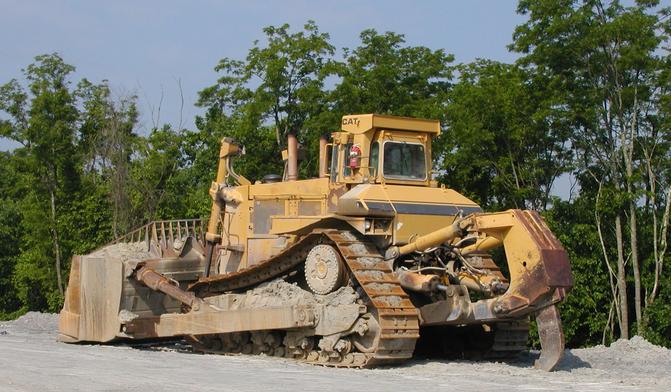
| Next Chapter | Previous Chapter | |
| Chapter 32: Changes in Strip Mining Techniques II | Contents | Chapter 30: Coal II |
The earliest strip mining in the area was done in WWI on Sam Sheets’ farm, which is now owned by the Woodfords. A son of Art Sheets, who was a brother of Sam Sheets, set up a company to mine Sams farm. It used a steam shovel that used a real steam engine and ran on steel tracks. The machine never got very far and, so I am told, remained on the hill until the hill was stripped after WWII by modern equipment. When the new stripping was started, the old rails were covered up with sediment washed in. But so much cover had been removed that four days of work with a bulldozer gave eight days worth of coal to load out.
(Illustration 31-1)

A Caterpillar D-11 used today in strip mining
Young Sheets’ company went broke. He ran off and left his uncle to go broke, too. Art had warned his brother, and would not help him. Sam’s wife committed suicide when the farm was lost, and Sam pretty much lost his mind. My mother said he had a large stone jar of the type used to make sauer kraut in the front yard, and he went there to do his bowel business, in view of anyone who happened to be on the road. He was a member of some fraternal organization, which took care of him. I remember visiting him in Parkersburg at the poorhouse when I was a child.
By WWII, methods had changed somewhat. I think our farm on Lost Creek was the first in the neighborhood to be stripped, around 1946. I have discussed the business aspects of this but want to describe the equipment and methods in some detail here. The bulldozer was common by this time, and it was used to remove the dirt and rock that lay over the coal. The rock often had to be drilled and shot with dynamite. The drills were vertical, and the explosive was sticks, ignited by a “cap” that was set off by electrical shock transmitted by wires.
Once the “overburden” was removed, the coal was drilled and shot, and loaded into six wheel trucks by a “steam shovel” which was run by diesel engines. Our farm was stripped by L. E. Cleghorn. I have only a vague memory of the knob shown in the 1912 topographic map of Harrison county which was leveled at this time. Cleghorn also took the “outcrop” coal, the coal with thin cover, which was highly weathered, around the rest of the hill.
The “spoil” was leveled off, leaving a “bench” which was supposed to slope back on a two percent grade to the center of an area with no highwall, or to the highwall in the strip around the hill. Big rocks were buried in dirt, so the surface was mostly small rocks and dirt. The pH was good in this area, and it soon was in good grass. A road was provided for access to the area above the highwall. The coal went to the tipple that stood on Ray Swisher’s place, now owned by Bernie Bennett, where Lost Creek turns almost due west three-fourths of a mile northwest of passing under the interstate.
When the coal at Lost Creek was stripped the second time, by Tony Petitto, stripping for Don Harrold, the situation had not changed much. Dozers and dynamite moved the overburden horizontally, and much of the drilling of rocks for explosives was done by a horizontal drill. The coal was placed in trucks to be hauled to the tipple by a loader, rather than by a steam shovel. By this time the trucks had two sets of wheels in the rear to support weight in the dump bed. Such trucks were called “ten wheelers.”
This time there were two benches when they were through backfilling. The coal consisted of two layers, thirty feet apart. The Redstone, three to five feet thick, was above the Pittsburgh, which was around eight feet thick. The first bench resulted from stripping the two seams to about an eighty foot high wall. Then they moved toward the hill and made a second cut on the Redstone that was not quite so high. The thinner seam did not justify moving as much overburden. The road over the highwall was long and dangerous, because it was so high. The coal was hauled to a tipple belonging to Tasa, mentioned above. Pardee and Curtain (originally a lumber company), the largest stripping company in Harrison County, had a tipple further up the valley, across the bridge, near where United Coals have their stone quarry in 2003. There were two other tipples on Lost Creek, one just beyond Righter toward the town of Lost Creek, mentioned two paragraphs above, and one a half- mile beyond the SDB Brick Church toward Mount Claire.
The big difference in technology was the use of the Compton coal auger. This device was moved up to the coal face when the high wall was stripped back as high as profitable and used to bore a hole in the vertical face, removing coal up to a distance of about two hundred feet back into the seam. If the seam was thick enough, one hole would be bored near the top and another directly below overlapping it to make a vertically elongated hole. When all that could be accessed from the first hole was removed, the machine would be moved horizontally enough to leave a pillar eight inches to a foot thick at the closest place, and drilling would begin again. The machine set on pads and was pulled by a bulldozer.
(Illustration 31-2)
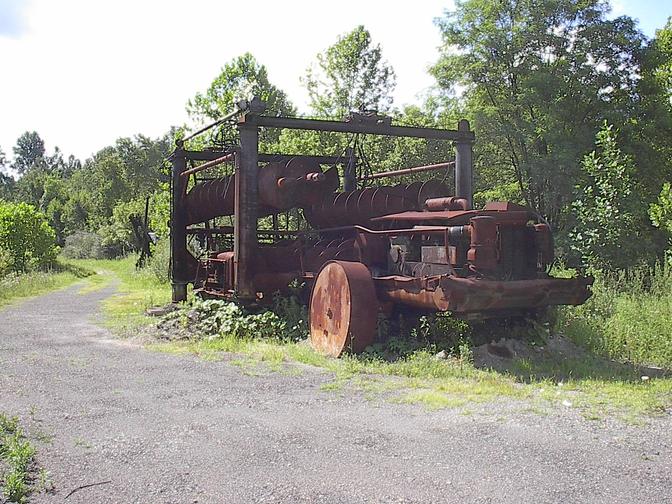
An abandoned coal auger. These pictures were taken on the road between Quiet Dell and Philippi about 2002. Mining with augers ended about 1970. The motor which drove the auger is at the right of the viewer. It moved back and forth on tracks as the auger entered the hill and was withdrawn to get another section of the auger set in from overhead storage. The motor which drove the very extensive hydraulics can be seen just ahead of the left rear post. When in use the wheels were taken off, they were used for transportation some distance only.
The concept is simple, but there were many hazards. The auger had to stay in the seam, not sloping either up or down, A little dirt made the coal unsaleable. If the holes crossed in the back, the hill would (Illustration 31-3)
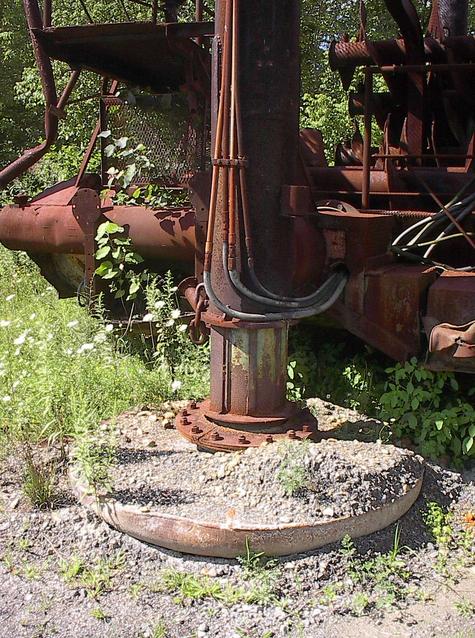
These machines had no wheels or tracks, they set on four of these platforms. The whole pillar above is a hydraulic cylinder to level the machine. It was pulled, one end at a time, by a bulldozer to move into postion for the next hole.
cave in and trap the auger, which would have to be left in the hill. Of course, the strip bench was never straight, so a good deal of thought went into planning how to get the maximum amount of coal out in the turns, concave and convex.
(Illustration 31-4)
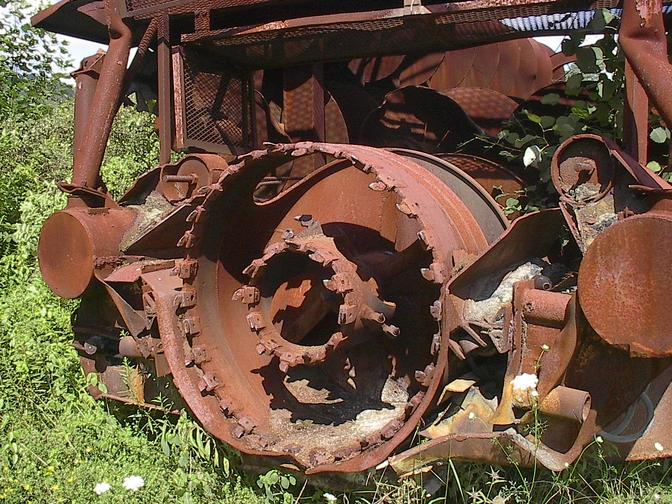
The “business end” which bored into the coal. Special removable bits can be seen mounted in the two circles, which turned together. These were very expensive and had to be changed frequently.
This stripping was done while I was away in the army. However, I had worked on one of these machines myself, the summer between the first and second year of college, a few years previously. It was on the first hill out of West Milford going toward Clarksburg, commonly called Kirby Hill, on the road off to the right. The auger sat on four round pads and above each of these was a huge hydraulic cylinder that raised the device up to the level of the coal. These also controlled the angle the auger went into the hill. The individual auger was about three feet in diameter and about thirty feet long. An engine turned the auger and drove it into the hill. This ran in a trough the size and shape of the auger.
(Illustration 31-5)
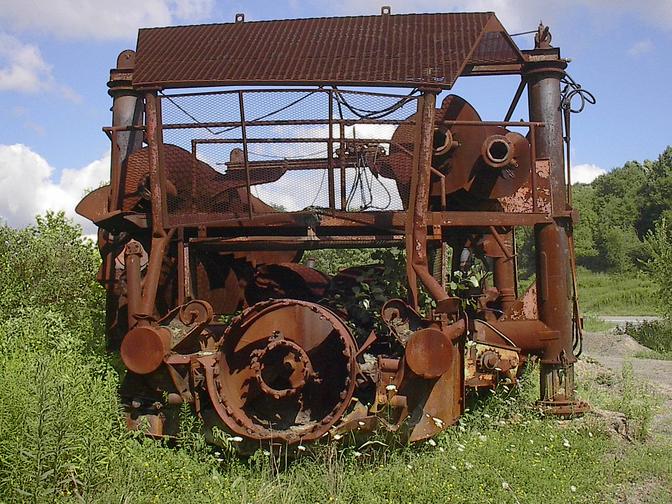
The machine viewed from the end toward the “highwall.” Notice the screen to protect workers from falling rocks and the additional augers stored to put in behind the first auger to push it deeper into the hill.
The “engine man” controlled this engine: how fast the auger turned and how fast it went into the hill. When the auger was all the way into the hill, he backed the engine out, and the “hookup man” moved another auger in the trough where it ran, and snapped it to the engine and to the auger already in the hill. That’s what I did. I also oiled and greased the machine. Dirty jobs go to the new guy!
The third man was the hydraulics operator, called the “operator.” There was a separate engine that ran the hydraulics. It was the hydraulics operator’s job to aim the auger into the hill with hydraulics and to start the conveyor when a stream of coal was coming out of the hill. He also guided the trucks back under the conveyor and was responsible for seeing they were properly loaded, with good balance front to rear and side to side on the truck. When the device was to be moved it was dragged by a dozer, very slowly. The operator was the boss and was paid the most, in part because aiming the auger was very important for profitability. Incidentally, the machine was designed for five men, which included two auger men and a oiler, but by the time I got to it they used only three men!
The coal was finely ground, lumps no more than three inches in diameter, and very clean for strip coal.
Compton made a fortune from selling the augers, and became a political power as well.
I grew up a lot on that job. The second day I was there a man was killed on the machine where I worked. The engine man had gone back into the hill for a bowel movement, but instead of going into an empty hole he went into the hole which held the auger, because it was more private. He didn’t tell anyone. The hydraulics operator got a new truck in place and started the conveyor before the engine man came out. The engine man tried to jump across the conveyor, fell through it but got a leg caught, and had his leg pulled off at the hip. The hydraulics operator was the first to detect anything wrong, he saw the engine man’s leg fall onto the truck. He stopped the conveyor and ran around the auger, about thirty yards. The man lay in the cold mud for about three hours before the ambulance came. I had completed a first aid course at Salem College and knew about shock, but they all thought he should not be touched. He died that night. Mom was ready to have me quit, but I didn’t.
(Illustration 31-6)
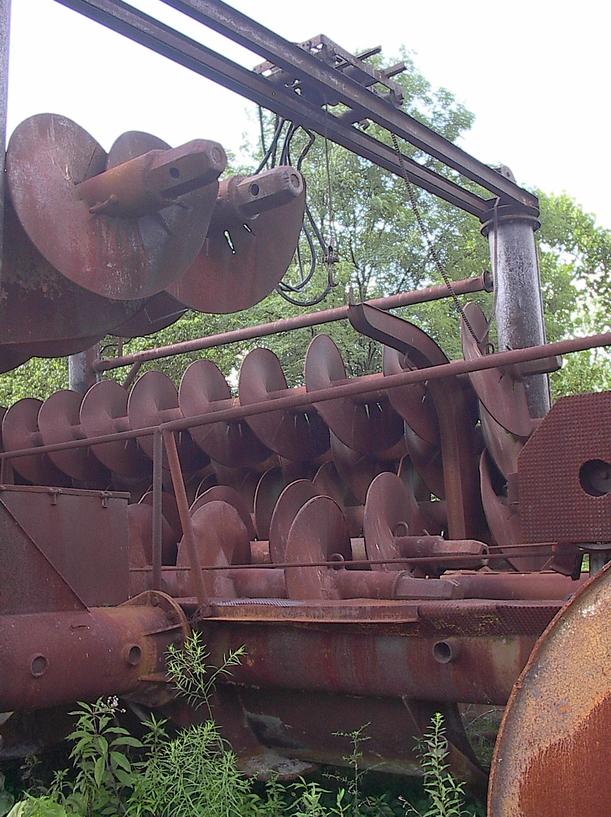
What the “hookup man” saw.
They had two coal augers on the job. One morning I came to work and the other machine had been buried by a slip of the high wall. I went to see it, and only about three feet of the twenty foot high rear hydraulic cylinders were in sight. It had happened at night, so no one was hurt. The company had it dug out in a couple of weeks and repaired, and it went back to work.
They had hired me to help because I was a kid wanting go to college. One week I worked eight hours a day for one company on the auger site, then went over to another site to help a mining engineering student put an “automatic oiler” on an old (now almost obsolete) diesel engine “steam shovel.” The “automatic oiler” was a device where the grease could be put in one place, and when a handle was worked grease went to all the places that needed greasing on the shovel. Pay for this went through a second company, and I had two full time jobs without being paid overtime. I was glad when the weekend came.
In August they announced a Company Party and dance on a Saturday night at a Lake Riley, near Weston. I decided to go, in spite of family objection. We all knew the principal entertainment would be consumption of alcohol in large quantities. I had never witnessed this sort of thing, but was as entitled to go as any other company member. I went and ate and enjoyed all those people in their altered states. Didn’t touch the stuff, never did. Later in life I discovered I can get silly enough being around drunk people, without the necessity of drinking it myself. Anyway, after just so much dancing and the principal entertainment, I got bored and went home. Monday there were no trucks running. I had to walk from Route 19 in to the office. When I got there, there the office was open but no one was in it. This was very strange. Finally, I started to walk back to the road, and one of the bosses came by in a pickup. He told me they had announced at the end of the party that the job had to close down; there would be no more work.
Aside When I was at Salem College, in the freshman or sophomore year our Professor, Crosby Rogers and a few of the chemistry majors went up to WVU to an American Chemical Society (ACS) meeting. In fact we went to several. These were always lectures about some aspect of chemistry, usually industrial chemistry of special interest. One was related to the coal industry and augered coal. Transistors had just been invented and were made from germanium, which is a very rare element. It seems that coal attracts germanium from above the seam and below it, so it is concentrated in the top few inches and the bottom few inches of a seam. The coal left behind by augering still had the germanium, and it was enriched by the degree to which non-germanium bearing coal had been removed.
Th e future of the transistor industry was bright. West Virginia would have a bright future, too, removing augered coal, burning it for the usual uses and extracting the germanium from the ashes for transistors, he said. Obviously it didn’t work out. In a couple of years someone learned how to make transistors from silicon, which comprises one-forth the earth’s crust.
| Next Chapter | Previous Chapter | |
| Chapter 32: Changes in Strip Mining Techniques II | Contents | Chapter 30: Coal II |
Copyright © 1998, 2006, 2008, 2011 S. Tom Bond (stombond at hughes.net)